| Founded | 1948 |
|---|---|
| Region | Kathmandu, Nepal |
| Most successful club(s) | |
The Tribhuvan Challenge Shield is Nepal's second oldest association football tournament, founded in 1948 by King Tribhuvan. [1]
| Founded | 1948 |
|---|---|
| Region | Kathmandu, Nepal |
| Most successful club(s) | |
The Tribhuvan Challenge Shield is Nepal's second oldest association football tournament, founded in 1948 by King Tribhuvan. [1]
In 1947 (2004 BS), Tribhuvan Challenge Shield was introduced by late H. M. King Tribhuvan for the development of this football game which was organized at Tudikhel in front of Haribhavan. In that tournament Naresh XI led by Nar Shumsher secured first position and N. R. T. team secured second position. In the same year Shree 3 Padma Shumsher introduced the Ram Janaki cup which was continuously won thrice by Police Force team. The same cup was again introduced but was renamed as Martyr's Memorial league football and hence League matches were introduced in Nepal.
In the year 1951 (2008 BS), Tribhuvan Challenge Shield knock-out football tournament was organized in which the team of Jaleshwor-11 bagged the shield. Police force team secured 1st position and N. R. T. second in the Marty's Memorial League tournament organized in the same year. Balsakha Dal introduced a new shield called Devi Maya Memorial Shield in the year 1952 (2009 BS) and in 1953 (2010 BS) Sankata Boys Sports team won the shield. Other tournaments of football were played in Singh Durbar itself up to the year 1953 (2010 BS). Although the construction of Dasharath Stadium had started just before the coronation of H. M. King Mahendra but football match was played there too on the occasion of coronation of H. M. King Mahendra.
On 12 March 1988, at least 93 people were killed and 100 more injured in a stadium crush at Dasarath Rangasala Stadium in Kathmandu, Nepal. The Tribhuvan Challenge Shield Cup match, between a team from Kathmandu and one from Bangladesh drew 30,000 fans. However the events spiralled out of control when a storm broke over the city, bringing lightning, 50-mph wind and hailstones. [2]
Nepal often experiences significant hailstorms during early spring, but the stadium only had one covered grandstand. Spectators panicked in their efforts to escape the pelting hail, and rushed to the sheltered west stand. When police pushed them back, they turned toward the exits. All but one of the stadium's eight exits were locked, and witnesses reported that most of the deaths occurred there as fans found the other gates closed.
| Year | Winner | Runner-up | ||
|---|---|---|---|---|
| 1948 | | Unknown | ||
| 1949 | Not Held | |||
| 1950 | ||||
| 1951 | ||||
| 1952 | | Unknown | ||
| 1953 | | |||
| 1954 | | |||
| 1955 | | |||
| 1956 | | |||
| 1957 | | |||
| 1958 | | |||
| 1959 | | |||
| 1960 | | |||
| 1961 | | |||
| 1962 | | |||
| 1963 | | |||
| 1964 | Not Held | |||
| 1965 | ||||
| 1966 | | Unknown | ||
| 1967 | | |||
| 1968 | | |||
| 1969 | | |||
| 1970 | | |||
| 1971 | Not Held | |||
| 1972 | ||||
| 1973 | ||||
| 1974 | ||||
| 1975 | ||||
| 1976 | | Unknown | ||
| 1977 | | |||
| 1978 | | |||
| 1979 | | |||
| 1980 | | |||
| 1981 | | |||
| 1982 | | |||
| 1983 | | |||
| 1984 | | |||
| 1985 | | | ||
| 1986 | | | ||
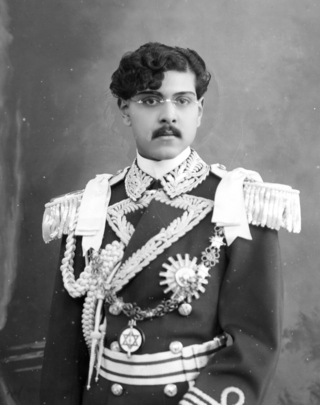
Tribhuvan Bir Bikram Shah was King of Nepal from 11 December 1911 until his death in 1955. Born in Kathmandu, the capital city of Nepal, he ascended to the throne at the age of five, upon the death of his father, Prithvi Bir Bikram Shah, and was crowned on 20 February 1913 at the Nasal Chowk, Hanuman Dhoka Palace in Kathmandu, with his mother acting as regent. At the time of his crowning, the position of monarch was largely ceremonial, with the real governing power residing with the Rana family.

Mahendra Bir Bikram Shah Dev was King of Nepal from 13 March 1955 until his death in 1972, which was due to heart attack as told in an interview by his personal physician Dr. Mrigendra Raj Pandey. Following the 1960 coup d'état, he established the partyless Panchayat system which governed the country for 28 years until the introduction of multiparty democracy in 1990. During his reign, Nepal experienced a period of industrial, political and economic change that opened it to the rest of the world for the first time after the 104-year-long reign of the Rana rulers, who had kept the country under an isolationist policy, came to an end in 1951.
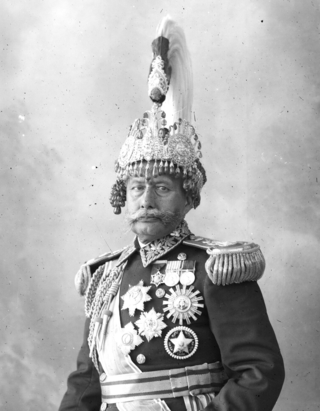
Field-Marshal Shree Maharaja Sir Mohan Shumsher Jung Bahadur Rana, GCB, GCIE, GBE was the Shree Tin Maharajah and foreign minister of Nepal from 30 April 1948 until 12 November 1951.
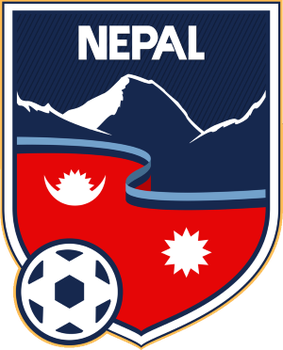
The Nepal national football team represents Nepal in International men's football, and is governed by the All Nepal Football Association (ANFA). A member of the Asian Football Confederation (AFC), the Nepali football team plays their home games at Dasharath Stadium in Kathmandu.

Dasharath Rangasala is a multi-purpose stadium in Tripureshwar, Kathmandu. It is named after Dasharath Chand, one of the four great martyrs of Nepal.

Friends Club is a Nepali professional football club from the Kopundole neighborhood of Lalitpur. The club is known for nurturing young talent of Nepalese Football. Friends Club has produced more than 200 national football players to date. It also organized certain social activities like reading room facilities, blood donations, bicycle rallies against drug abuse etc.
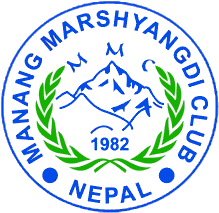
Manang Marshyangdi Club is a Nepali professional football club based in Kathmandu, that competes in the Martyr's Memorial A-Division League. The club is record champion of Nepalese football, having won 8 National Championship Titles. Historically, they have a fierce rivalry with Three Star Club and Nepal Police Club, a departmental team. The other rival includes New Road Team.
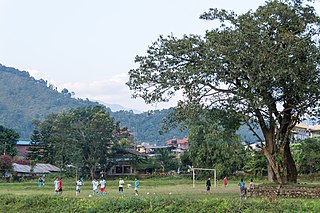
Football is one of the major and the most popular sports of Nepal. It is governed by the All Nepal Football Association (ANFA). The present acting president of ANFA is Karma Kshiring Sherpa. The current top domestic league is the Martyr's Memorial A Division league. The Nepal national football team represents Nepal in all international competitions.

Nepal Police Club is a sports club owned and managed by the Nepal Police. The club is best known for its football section which competes in the Martyr's Memorial A-Division League, the top flight of Nepali club football.
Commander in Chief Kiran Shamsher Jang Bahadur Rana (1916–1983) was a Nepalese army officer. He served as the Royal Nepalese Army's Commander-in-Chief from 1951–1956 and as the Nepalese ambassador to the United Kingdom from 1973–1977. Over the course of thirty years, he served as Aide-de-camp General to King Tribhuvan, King Mahendra and King Birendra.

Cricket is the most popular sport in Nepal. It is played by many people throughout the country, especially in the Terai region. The biggest cricketing achievement of the national cricket team was when the team reached the qualification tournament of 2014 ICC World T20 held in Bangladesh. Nepal's playing season runs from September to November and starts again in March before finishing in May. The National Cricket Academy, NCA, was formally opened in January 2013 by the Cricket Association of Nepal to guide emerging players and to provide continuous training facilities to the men's national team, women's national team and the under-19 team. As of December 2012, there were 429 senior cricket clubs and 227 junior cricket clubs in Nepal.
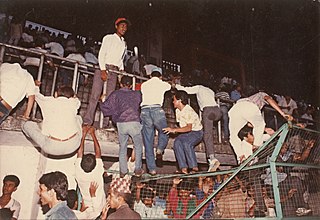

Dharma Bhakta Mathema (1909—1941) was a professional body builder as well as a founding member of Praja Parishad. He introduced modern body building techniques in Nepal, but had gained popularity for his contribution to the Nepalese struggle for freedom against the autocracy of the Rana dynasty. He was killed during the freedom movement, and he is duly recognized as one of the four martyrs of Nepal of the Rana era.
The ANFA Cup refers to a series of invitational association football knockout tournaments organised by the All Nepal Football Association. Both National football teams as well as football clubs participated in the past.

The revolution of 1951 in Nepal, also referred to as Sat Salko Kranti, was a political movement against the direct rule by the Rana dynasty of Nepal which had lasted for 104 years. It marks the beginning of the political awakening and democratic movements in Nepal, and resulted in immediate abolition of the institutionalized hereditary Prime Minister system in Nepal.
Delhi Accord was a tripartite agreement (verbal) in Delhi after mutual agreement between Ranas, Nepali congress party and King Tribhuban.

Bahadur Bhawan is a Rana palace in Kathmandu, the capital of Nepal. The palace complex, located west of Jamal, north of Keshar Mahal was incorporated in an impressive and vast array of courtyards, gardens and buildings. Initially the palace was built by Bir Shumsher JBR and was rebuilt by Rudra Shumsher JBR after its destruction by fire in BS 1962.
The 1999 ANFA National League Cup was a domestic cup association football competition organised by the All Nepal Football Association. It was held on 20 November to 30 November 1999, and was called the 1999 ANFA Coca-Cola National League Cup for sponsorship reasons.
Birat Gold Cup is an annual football tournament held in Biratnagar, the second largest metropolitan city of Nepal. It has been held at the Sahid Rangsala Stadium since 2012. The event witnesses participation from several national and international teams, and is amongst the most sought after football tournament of the nation.

Sardar Rudra Raj Pande (1901–1987) was a Nepali educator, writer and historian. He served as the Headmaster of Durbar High School from 1925 to 1938, the Headmaster of Tri-Chandra College from 1938 to 1951 and the Vice Chancellor of Tribhuvan University from 1964 to 1969. He wrote multiple novels including Rupamati, which is considered as one of the earliest novels written in Nepali language. He also played an active role in establishing SLC examination board and Department of Archaeology.